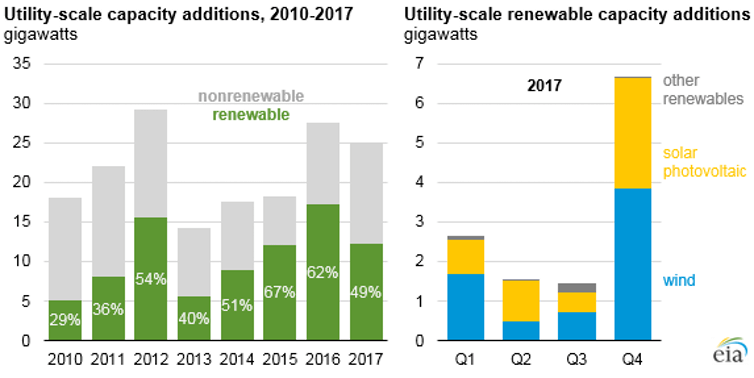
The Illinois Future Energy Jobs Act (FEJA) was signed into law on December 7, 2016 and went into effect on June 1, 2017. There were many items in this legislation, but for the purposes of this article, we would like to concentrate on the Renewable Portfolio Standard (RPS) updates that were part of the legislation.
One of the requirements of FEJA is that the three investor-owned utilities (Ameren, ComEd, and Mid-American) in Illinois must source a certain percentage of all retail electricity sales from renewable energy each year, culminating in 25% from renewable energy by 2025. This is the new Renewable Portfolio Standard (RPS). Utilities must meet the annual RPS targets via the purchase of renewable energy credits from renewable energy systems, using a secure budget of $200M/year. An existing 2% cost on consumer electricity rates will fund the RPS budget. One requirement of FEJA is that 4,300 megawatts of new solar and wind power electricity generation be built. There is already 4000 MW of wind power and 60 MW of solar power installed in Illinois. Under FEJA, an additional 1300 MW of new wind power is to be built, an increase of 33%. For solar power, 3000 MW will be built, a 5000% increase over the current levels. As would be expected, this type of program will take a long time to implement, and the Illinois Commerce Commission (ICC) just approved the Final Plan in April 2018. While it is a final plan, the duration of the program requires that the plan have the flexibility to change and this is outlined in the Illinois Power Agency’s Long-term Renewable Resources Procurement Plan issued on August 6, 2018. Our goal in this article is to provide some general information on the plan to our customers.
The mechanism to provide funding for these projects is through an implementation of a different Renewable Energy Credit (RECS) program. A Renewable Energy Credit (REC) is a tradeable environmental asset that represents the clean attributes of renewable electricity. For the purposes of the Illinois RECS program, 1 REC = 1,000 KWS. The RECS program will be administered by the Illinois Power Agency. The central tenant of the program is the requirement that the main utilities purchase RECS that will promote three diverse types of renewable energy development: utility-scale and brownfield (contaminated land or closed landfills) renewable energy projects, general market community solar and on-site solar projects (Adjustable Block Program), and low-income community solar and on-site solar projects (Illinois Solar for All Program).

Source – U.S. Energy Information Administration (2018)
Many of our procurement clients may be impacted by on-site solar or community solar, so we will comment on these specific programs. On-site solar is often referred to as rooftop solar or distributed generation. The system is usually on the customer’s property, and the system directly powers the home or the building. Residential on-site systems are typically between 3-10 KW in size, where commercial on-site systems are between 10KW-2MW depending on the type and size of the business. Community solar is a somewhat new concept that has been growing in prominence, and it may hold the most promise going forward for customers who would like to use renewable energy and be subsidized for doing so. Community solar is often termed “shared solar,” and the electricity generated is shared among a group of varied stakeholders that include households and businesses. This is ideal for areas where there is suitable land (flat, clear path to the sun and close to electrical grid infrastructure) available for a solar electricity installation.
ComEd has supported community solar with the creation of a specific rider called the Parallel Operation of Retail Customer Generating Facilities Community Supply (Rider POGCS). A community supply project is defined by ComEd as a renewable generating facility that is a non-residential retail customer that meets one or more of three statutory criteria.
- Owned or leased by a group of retail customers, and/or
- Serves retail customers at premises located in a single building
- A community renewable generation project (defined in the Illinois Power Agency Act)
The Rider is a roadmap for community solar projects and the requirements and obligations of community solar projects and must be understood by both the developers of the project and the subscribers and beneficiaries of the project.
The renewable energy portion of the Futures Energy Jobs Act is now reaching the implementation stage. There is potentially a wave of investment in solar projects about to be implemented in the next few years due to the REC subsidies that developers will receive. This is in addition to the still existing federal tax and production credits that developers can receive for the installation of renewable energy facilities. This development is one of the reasons that there has been pressure on the back end of the forward curves in the PJM/ComEd area as there is a general perception that these installations will increase the supply more than demand will grow. While this may be true, it is important to recognize that it may also be true that natural gas will remain the electricity generating fuel on the margin, and its price will probably continue to have the biggest influence on wholesale electricity costs in the PJM/ComEd region.
Sources: Illinois Power Agency (IPA), Illinois Commerce Commission (ICC), ComEd, and The Sierra Club



